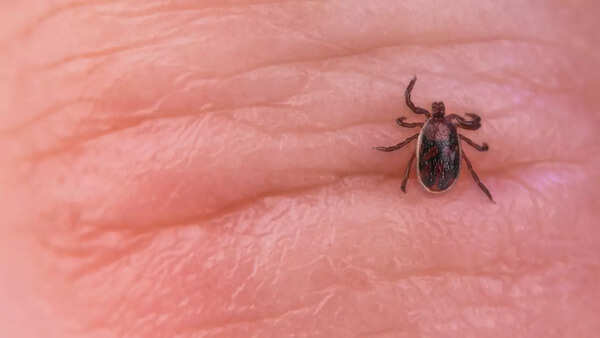Maria Palen, a 31-year-old chemical engineer from California, embodied the image of a fitness guru. With a dedicated plant-based diet and consistent exercise, she amassed over 20,000 Instagram followers documenting her journey. However, her story took an unexpected turn when she was diagnosed with babesiosis, a parasitic infection transmitted by tick bites, leading to paralysis from the waist down by late 2024.
This ordeal highlights that outward appearances of health can mask underlying medical battles. Maria's experience serves as a stark reminder of the potential dangers of tick-borne illnesses, especially for those who enjoy outdoor activities.
 *A tick, the source of potential health risks.*
*A tick, the source of potential health risks.*
Initially, Maria experienced mild symptoms such as inflammation, joint discomfort, and thumb pain. She attempted to address these issues through diet and exercise. Unfortunately, her condition deteriorated.
By March 2024, she was largely confined to her bed. Simple tasks became challenging. Eventually, a specialist identified babesiosis, a less-known tick-borne disease caused by Babesia parasites that infect red blood cells. Unlike Lyme disease, babesiosis often goes undetected due to its flu-like symptoms. The Centers for Disease Control and Prevention (CDC) reports that babesiosis cases have doubled in the last decade, rising from 1,000 in 2011 to approximately 2,500 annually.
Maria suspects that she contracted the tick bite years prior, possibly during a hike. The infection gradually impacted her nervous system, leading to extreme tailbone pain and eventually paralysis.
Tick bites are often unnoticed due to their small size and lack of pain. A significant concern is the potential for infections to remain dormant for extended periods. Maria's case highlights the lack of awareness surrounding lesser-known tick-borne diseases like babesiosis, rather than negligence on her part.
Ticks are most active during warmer months and thrive in grassy or wooded environments. The 2024 tick season in the US was particularly severe due to milder winters, resulting in increased survival rates for animals that host ticks. This surge in tick populations elevates the risk of rare infections spreading, according to researchers at the University of California, Riverside.
The microbes responsible for babesiosis (Babesia microti and B. duncani) are difficult to detect as they reside within red blood cells. Recent research on the genome of B. duncani reveals its similarities to the malaria parasite, explaining symptoms like fever, chills, and muscle aches.
Maria’s story emphasizes the importance of early detection. While doctors often test for Lyme disease when a tick-borne illness is suspected, babesiosis may not be considered. Given that it can coexist with Lyme disease, symptoms can be misattributed. Therefore, healthcare providers should adopt a broader approach, and individuals should monitor for unexplained changes in energy levels, muscle strength, or chronic pain, particularly after spending time outdoors.
The risk extends beyond hiking and camping. Gardening in overgrown backyards or walking through wooded areas can also pose risks, especially without protective clothing or tick repellents.
While common advice includes wearing long sleeves and checking for ticks, Maria’s case necessitates a more detailed approach:
[This article is intended for informational purposes only and is not a substitute for professional medical advice. For any symptoms or health concerns, please consult a licensed healthcare provider]
Newer articles
Older articles
 Moto G54 Gets Significant Price Cut in India, Making Budget Smartphone Even More Appealing
Moto G54 Gets Significant Price Cut in India, Making Budget Smartphone Even More Appealing
 Africa's Rift Valley: Mantle Upwelling Drives Continent's Split and Birth of New Ocean
Africa's Rift Valley: Mantle Upwelling Drives Continent's Split and Birth of New Ocean
 X Cracks Down: Over Half a Million Indian Accounts Suspended for Policy Breaches
X Cracks Down: Over Half a Million Indian Accounts Suspended for Policy Breaches
 Vijay Sethupathi Apologizes Amid Controversy Over Son Surya's Debut Film 'Phoenix'
Vijay Sethupathi Apologizes Amid Controversy Over Son Surya's Debut Film 'Phoenix'
 Jadeja's Accuracy Questioned: Ex-India Pacer Slams Spin Strategy in England Test Loss
Jadeja's Accuracy Questioned: Ex-India Pacer Slams Spin Strategy in England Test Loss
 IRCTC's AI Chatbot Revolutionizes Train Ticket Booking, Refunds, and Information Access
IRCTC's AI Chatbot Revolutionizes Train Ticket Booking, Refunds, and Information Access
 Ashada Gupt Navratri 2025: Unveiling Dates, Sacred Rituals & Hidden Significance of the Monsoon Festival
Ashada Gupt Navratri 2025: Unveiling Dates, Sacred Rituals & Hidden Significance of the Monsoon Festival
 Google Maps Enhances Directional Accuracy with Fused Orientation Provider Update
Google Maps Enhances Directional Accuracy with Fused Orientation Provider Update
 xAI to Open Source Grok, Democratizing Access to Musk's AI Chatbot
xAI to Open Source Grok, Democratizing Access to Musk's AI Chatbot
 Android Users Urged to Patch Now: Critical Security Flaws Expose Devices to Attacks
Android Users Urged to Patch Now: Critical Security Flaws Expose Devices to Attacks